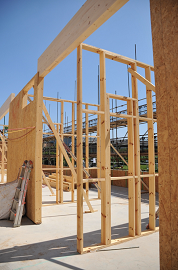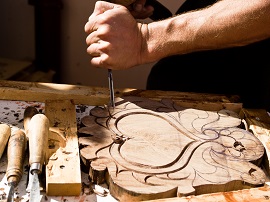Hardwood
Contents |
Introduction
Hardwoods are one of the most common types of wood used in manufacturing; everything from oak furniture to a mahogany mantelpiece are constructed with the hardwood. But what makes hardwood so special, and why is it different to traditional softwoods?
What are hardwoods?
Hardwoods are types of wood that come from deciduous trees – trees where their leaves fall every autumn. Some of the most common types of hardwood trees include oak, mahogany, ash, beech, and birch.
One reason hardwoods are known as hardwoods is because they tend to grow a lot more slowly than other types of trees, which results in the trunk, bark, and branches becoming denser, which can be a great benefit for carpenters and people that use wood on a regular basis.
Because of the increased density of the tree, the wood is more 'heavy duty' than its soft counterparts, which is why it is typically used in furniture such as tables, chairs, chest drawers, and so on.
The difference between hardwoods and softwoods
Traditional hardwoods, such as oak, can show annual growth rings, meaning that carpenters and tree enthusiasts can determine how old certain types of wood are, and that can determine various important characteristics of the wood. For example, the more rings there are, the denser it will be, meaning that it is a much higher quality hardwood compared to one that has very few rings.
However, people tend to associate hardwoods with hardness, but this isn’t always the case. For example, balsa is a common hardwood but it is generally softer than softwoods.

|

|
| Softwood | Hardwood |
Applications of hardwoods
Hardwoods have a wide range of applications, being used for fuel, tools, furniture, flooring, barrels, and the manufacturing of charcoal. The important thing is that, because hardwoods take longer to develop, they are more expensive, which is why they aren’t used as much as softwoods in industries, such as construction.
Hardwoods also have a complex structure, meaning they can produce beautiful features on the wood itself. For example, if you cut a hardwood tree horizontally, you will notice the annual growth rings, but, if you cut a hardwood tree vertically, you will notice the lines that run along the wood that is formed from the xylem tubes; this is known as the grain.
Because of its complex nature, unusual structures can form easily within the wood, such as extra branches protruding out of the wood. When the wood is cut, round ovals of darker wood can be seen, which are known as knots.
However, knots can actually weaken the structure of the wood itself, so it is important to make sure that you use wood with little knots for uses that require wood’s strength. For furniture items, strength isn’t a necessity, because people tend to focus more on the aesthetics of the wood, and it can definitely be said that hardwood with knots looks more aesthetically pleasing than plain hardwood.
--G&S Specialist Timber 09:11, 16 Feb 2017 (BST)
Related articles on Designing Buildings Wiki
- 11 things you didn't know about wood.
- Ancient Woodland.
- Bamboo flooring.
- Birch wood.
- Boardwalk.
- Cross-laminated timber.
- Decking boards.
- Definition of tree for planning purposes.
- Engineered bamboo.
- Forests.
- Janka hardness rating scale.
- Laminated veneer lumber LVL.
- Modified wood.
- Natural materials.
- Padauk wood.
- Panelling.
- Physical Properties of Wood.
- Plywood.
- Recognising wood rot and insect damage in buildings.
- Softwood.
- Sustainably procuring tropical hardwood.
- Testing timber.
- The Differences Between Engineered Flooring and Solid Hardwood Flooring.
- The differences between hardwood and softwood.
- Timber.
- Timber construction for London.
- Timber framed buildings and fire.
- Timber preservation.
- Timber vs wood.
- Types of timber.
- Walnut.
- Wrot timber.
Featured articles and news
Latest Build UK Building Safety Regime explainer published
Key elements in one short, now updated document.
UKGBC launch the UK Climate Resilience Roadmap
First guidance of its kind on direct climate impacts for the built environment and how it can adapt.
CLC Health, Safety and Wellbeing Strategy 2025
Launched by the Minister for Industry to look at fatalities on site, improving mental health and other issues.
One of the most impressive Victorian architects. Book review.
Common Assessment Standard now with building safety
New CAS update now includes mandatory building safety questions.
RTPI leader to become new CIOB Chief Executive Officer
Dr Victoria Hills MRTPI, FICE to take over after Caroline Gumble’s departure.
Social and affordable housing, a long term plan for delivery
The “Delivering a Decade of Renewal for Social and Affordable Housing” strategy sets out future path.
A change to adoptive architecture
Effects of global weather warming on architectural detailing, material choice and human interaction.
The proposed publicly owned and backed subsidiary of Homes England, to facilitate new homes.
How big is the problem and what can we do to mitigate the effects?
Overheating guidance and tools for building designers
A number of cool guides to help with the heat.
The UK's Modern Industrial Strategy: A 10 year plan
Previous consultation criticism, current key elements and general support with some persisting reservations.
Building Safety Regulator reforms
New roles, new staff and a new fast track service pave the way for a single construction regulator.
Architectural Technologist CPDs and Communications
CIAT CPD… and how you can do it!
Cooling centres and cool spaces
Managing extreme heat in cities by directing the public to places for heat stress relief and water sources.
Winter gardens: A brief history and warm variations
Extending the season with glass in different forms and terms.
Restoring Great Yarmouth's Winter Gardens
Transforming one of the least sustainable constructions imaginable.






















